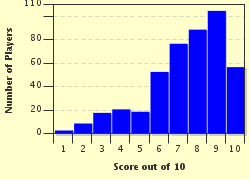Quiz Answer Key and Fun Facts
1. In ancient times, the various states of Greece, regardless of whether they were at war and with whom, sent athletes to Olympia every four years to compete against one another. In the late 19th century, when frequent wars ravaged Europe, dreamers looked to this Olympic example. Name the man whose spark of inspiration and considerable force of will led to the first modern, international, amateur Olympic Games in 1896.
2. The initial inspiration for golf is shrouded in mystery. Did the game originate in China, or in Ancient Rome, or perhaps in the Netherlands? Despite this uncertainty, scholars are happy to credit Scotland with inventing the game in its modern form. What town in Fife, host of the Royal and Ancient Golf Club, is widely considered the home of golf?
3. Cricket is one of those sports that grew up gradually; it dates back at least to the mid-sixteenth century, and its inventors are lost to history. Modern cricket, though, relies on formalized Laws of Cricket for everything from the weight of a ball to the circumstances in which a substitute may field. What organization has had the Laws in its charge since 1788?
4. Basketball is quite young, as team sports go: it was invented in December 1891 by a Massachusetts gym teacher who wanted to encourage fitness on a cold and rainy day. What institution, immortalized in song nearly 100 years later, was the site of the very first basketball game?
5. Nowadays, doctors, scientists, and athletes have developed a deep body of knowledge about the science of running, but in the early days of track and field runners relied on gut feeling and superstition. The standard "crouch start" wasn't used in a sprint race until 1888! What 1929 invention, now ubiquitous at international competitions, facilitates the crouch start?
6. Association football, also known as soccer, may well be the most popular sport in the world. International matches are commonplace, and every four years the World Cup raises hopes and passions around the globe. In the early years of the 1900s, several football associations were inspired to join forces and form an international body to govern the sport. What is the name of this group, which hosted the first World Cup twenty-six years after its founding?
7. It can sometimes be hard to distinguish between founding history and founding legend - and the officials of a sport don't always help the situation. Take baseball. Abner Doubleday is claimed to have founded the sport in what New York municipality, which soon became the home of the National Baseball Hall of Fame and Museum?
8. The pinnacle of modern cycling events is the Tour de France, a three-week staged race that attracts somewhere in the neighborhood of 180 bicyclists every year. Its initial spark of inspiration, though, didn't come from high-minded athleticism, but from something much more mundane. Who sponsored the very first Tour de France in 1903?
9. It's a fair bet that people have boxed each other for as long as they've been able to make fists, but it hasn't always been a regulated sport. After a few other attempts at codifying rules, one rule set truly took off after its 1867 publication, and came to govern boxing around the world. What is the name of these rules, which (among other things) introduced boxing gloves?
10. The marathon runner is the modern epitome of athletic endurance, but the inspiration for the race comes from an ancient legend. Supposedly, in 490 BC, a man named Pheidippides ran all the way to Athens with news of a great victory at the Battle of Marathon. What happened to him afterward?
Source: Author
CellarDoor
This quiz was reviewed by FunTrivia editor
stuthehistoryguy before going online.
Any errors found in FunTrivia content are routinely corrected through our feedback system.

